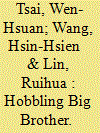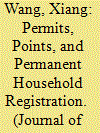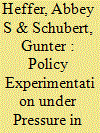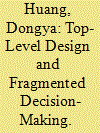| Srl | Item |
| 1 |
ID:
179164


|
|
|
|
|
| Summary/Abstract |
This article argues that policy implementation in China has moved toward a system under which the center formulates a blueprint or “top-level design” from which local officials devise detailed regulations through a process of “crossing the river by feeling for stones.” This applies to the development of China’s new social credit system. To minimize political risk, when implementing it local officials have selected easier goals from the “top-level design” blueprint. In City Z, for example, we find that promoting integrity among businesses is less risky than promoting integrity among civil servants or the general public, so less progress has been made in the latter two areas when putting in place integrity credit-point systems. The risks involved in promoting social credit among the general populace are the greatest, so the city’s efforts in this have been limited. From our empirical study of China’s social credit system in City Z, we draw some conclusions about policy implementation under Xi Jinping.
|
|
|
|
|
|
|
|
|
|
|
|
|
|
|
|
| 2 |
ID:
178305


|
|
|
|
|
| Summary/Abstract |
China’s New-type Urbanisation Plan heralded a new phase of reform of the household registration (hukou) system and initiated a nation-wide reconfiguration of hukou policy in Chinese cities. This study reveals that the former localisation of hukou policymaking has been brought to greater uniformity under the current central guidelines. The liberalisation of hukou conversion has been expanded to many large cities that previously employed selective migrant integration policies. Mega-cities have recalibrated the selection criteria for new citizens, elevating the importance of settlement duration and moderating the importance of educational and professional qualifications. Case studies in Guangdong further reveal the dynamic interactions among different levels of government in the course of reform. Local policy experimentations set important precedents for central policymaking, and the central guidelines are enforcing new adjustments in local implementation. The provincial government plays a prominent role in coordinating top-down directives and local conditions.
|
|
|
|
|
|
|
|
|
|
|
|
|
|
|
|
| 3 |
ID:
190404


|
|
|
|
|
| Summary/Abstract |
Many studies put forward the argument that local policy experimentation, a key feature of China's policy process in the Hu Jintao era, has been paralysed by Xi Jinping's (re)centralization of political power – otherwise known as “top-level design.” This narrative suggests that local policymakers have become increasingly risk-averse owing to the anti-corruption campaign and are therefore unwilling to experiment. This article, however, argues that local governments are still expected to innovate with new policy solutions and now will be punished if they do not. By introducing the analytical framework of “experimentation under pressure” and drawing on an analysis of over 3,000 local government regulations and fieldwork data related to foreign investment attraction policies in two localities, Foshan and Ganzhou, the authors highlight new features developing within current experimental policy cycles. Local cadres now have no choice but to experiment as the political risk of shirking the direct command to experiment may be higher than the inherent risk of experimentation itself.
|
|
|
|
|
|
|
|
|
|
|
|
|
|
|
|
| 4 |
ID:
169967


|
|
|
|
|
| Summary/Abstract |
State-owned enterprise (SOE) reforms have typically been considered the result of bargaining under China’s fragmented bureaucratic structure. This study uses the case of the CNR–CSR merger to investigate the latent changes that have recently occurred in the policy-making structure of SOE reforms. This study will demonstrate that ‘top-level design’—in the context of a strengthened political authority and centralised political power—dominates SOE reforms and changes the pattern of fragmented interest bargaining among government departments and SOEs. In this context, the national strategy can be implemented with little resistance, contradicting scholarly predictions of fragmented authoritarianism. However, the top-level design does not appear to be based on a rational decision-making process; rather, its goals are vague, and the methods for achieving them have not been debated rationally. The policy-making process in this case study involved figuring out the top-level leaders’ intentions and rationalising the decisions afterwards. A top-level design with weak rationality may have risky consequences.
|
|
|
|
|
|
|
|
|
|
|
|
|
|
|
|